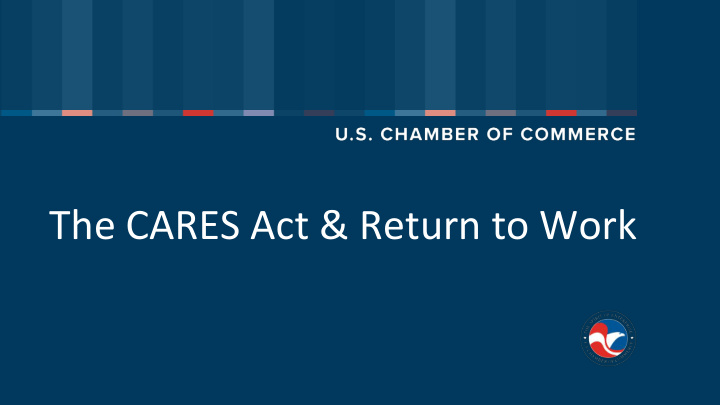



The CARES Act & Return to Work
Overview & Major Provisions for Individuals $2 Trillion Package • Through the Federal Reserve potential for additional $4 trillion in support for the economy • Referred to as the “Phase 3” Bill Automatic Payments to Individual Taxpayers • $1,200 per individual ($2,400 joint return) + $500 per child • Phased out for incomes above $75,000 ($150,000 joint) Expanded Unemployment • Most restrictions on eligibility suspended if related to COVID-19 • Additional $600 per week on top of regular state benefit (through July 31) • Eligibility ends when individual can return to work • Benefits provided through State UI offices
CARES Act Assistance Available to Small Businesses PPP: EIDL: Employee Retention Tax Credit: • • • $349 Billion $310 Billion $50 Billion Loans $10 Billion Grants Up to $5 k per employee • • • < 500, Self-Employed, Independent < 500, Self-Employed, Independent Employer fully or partially closed or Contractors Contractors drop of 50% in quarterly gross • • Loans equal to 2 ½ months payroll Low interest loan receipts • • • Loans can convert to grants Up to $10 k grant Different rules for above and below • • Apply through banks & other Apply through SBA 100 employees • lenders Ineligible if accept PPP Payroll Tax Deferment: • Defer employer portion of payroll taxes • Repay 50% 12/31/21, 50% 12/31/22 • Ineligible if accept PPP loan forgiveness
Main Street Lending • Federal Reserve Supported • U.S. Businesses Less Than 10,000 Employees or $2.5 Billion Revenue • Loans Through Banks • May 1 Start Likely • Restriction on Stock Buybacks, Dividends, Executive Compensation What to Watch: • Minimum Loan Amount • Maximum Loan Amount • Eligibility • Restrictions
PPP Loans to Date • 1,667,367 Loans Approved by SBA • Made by 4,975 Lenders • 74% of Loans Under $150,000 • Average Loan Amount: $206,000 PPP Loans Moving Forward • At Average Loan Amount, $310 Billion Supports 1.5 Million More Loans • $60 Billion Set Aside for Smaller Banks, Credit Unions, CDFIs
Return to Work: White House Guidelines for all phases • Develop and implement appropriate policies, in accordance with Federal, State, and local regulations and guidance, and informed by industry best practices, regarding: ✓ Social distancing and protective equipment ✓ Temperature checks ✓ Sanitation ✓ Use and disinfection of common and high-traffic areas ✓ Business travel • Monitor workforce for indicative symptoms. Do not allow symptomatic people to physically return to work until cleared by a medical provider. • Develop and implement policies and procedures for workforce contact tracing following employee COVID+ test.
White House Phase 3 Phase 1 Phase 2 • ENCOURAGE TELEWORK • • Resume UNRESTRICTED Close COMMON AREAS and • RETURN TO WORK IN PHASES STAFFING of worksites enforce moderate SOCIAL • Close COMMON AREAS and enforce Employers DISTANCING strict SOCIAL DISTANCING • Minimize NON-ESSENTIAL TRAVEL • SPECIAL ACCOMMODATIONS for the VULNERABLE POPULATION • LARGE VENUES can operate • SCHOOLS AND ORGANIZED YOUTH • SCHOOLS AND ORGANIZED YOUTH under limited physical distancing. ACTIVITIES remain closed. ACTIVITIES can reopen. Specific • GYMS can operate with standard • BARS should remain closed. • BARS can reopen with diminished Employers sanitation protocols. • LARGE VENUES can reopen with strict occupancy. • BARS can operate with increased • LARGE VENUES can operate with physical distancing protocols. standing room occupancy. • GYMS can reopen with strict physical moderate physical distancing protocols. distancing and sanitation protocols.
Return to Work Issues • Role of Employers in Testing, Tracing, Health Monitoring • Guidance vs. Regulations • Legal Liability • Patchwork of Rules • Resources, Especially for Certain Businesses
Recommend
More recommend